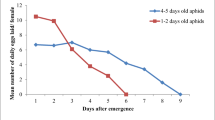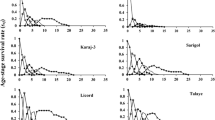Abstract
A 2-year study on the preference and performance of Lipaphis erysimi on different Brassica species in the field and under greenhouse conditions revealed that rapeseed (B. campestris var. BSH-1, B. campestris var. YSPB-9) and mustard (B. juncea RH-30) were better hosts for this aphid than other Brassica species (B. napus, B. nigra, Eruca sativa, B. carinata). On the first group of plants, the rate of nymphal development, longevity and fecundity of this pest were significantly less than on the second group of plants. Development was significantly prolonged when the aphid was reared on second group of plants.







Similar content being viewed by others
References
Agarwal N, Rohilla HR, Singh H (1996) Evaluation of rapeseed mustard genotypes against mustard aphid, Lipaphis erysimi (Kalt.) at inflorescence stage. Ann Biol 12:93–95
Ahlawat YS, Chenulu VV (1982) Studies on the transmission of radish mosaic virus by aphid, Lipaphis erysimi. Indian Phytopathol 35:633–638
Amjad MD, Peters C (1992) Survival, development, and reproduction of turnip aphids (Homoptera: Aphididae) on oilseeds Brassica. J Econ Entomol 85:2003–2007
Anonymous (2003) Package of practices for Rabi crops for north western plain region. CCS HAU Hisar, p 87
Bakhetia DRC (1983) Losses in rapeseed and mustard due to Lipaphis erysimi (Kalt.) in India. A literature study. Int Rapeseed Conf 6:16–22
Bakhetia DRC (1987) Insect pests of rapeseed-mustard and their management. In: Veerbhadra Rao M, Sithanathan S (eds) Plant protection in field crops. PPAI, Rajendranagar, pp 249–259
Bhadoria NS, Jakhmola SS, Dhamdhere SV (1995) Relative susceptibility of mustard cultivars to Lipaphis erysimi in North West Madhya Pradesh (India). J Entomol Res 19:143–146
Bonnemaison L (1965) Insect pests of crucifers and their control. Annu Rev Entomol 10:230–256
Brar KS, Sandhu GS (1978) Comparative resistance of different Brassica species/varieties to the mustard aphid (Lipaphis erysimi Kalt.) under natural and artificial conditions. Indian J Agric Res 12:198–200
Bridges M, Jones ME, Bones AM, Hodgson C, Cole R, Bartlet E, Wallsgrove V, Karapapa KV, Watts N, Rossiter JT (2001) Spatial organization of the glucosinate-myrosinase system in brassica specialist aphids is similar to that of the host plant. Proc R Soc Lond Ser B 233:1–5
Castle SJ, Perring TM, Farrar CA, Kishaba AN (1992) field and laboratory transmission of watermelon mosaic virus 2 and zuchhini yellow mosaic virus by various aphid species. Phytopathology 82:235–240
Guan ZH, Wang S (1980) The influence of the aphid (Lipaphis erysimi, Myzus persicae) saliva on the infectivity of TPMV (turnip mosaic virus) on Chinese cabbage. Acta Chem Sin 1:83–85
Kennedy GC, Abou-Ghadir MF (1987) Bionomics of the turnip aphid on two turnip cultivars. J Econ Entomol 172:754–757
Klingauf FA (1987) Host plant finding and acceptance. In: Mink AK, Harrewijn P (eds) Aphids, their biology natural enemies and control. Elsevier, Amsterdam, p. 220
Liu T, Yue B (2001) Comparison of some life history parameters between alate and apterous forms of turnip aphid (Homoptera: Aphididae) on cabbage under constant temperatures. Florida Entomol 84:239–242
Liu SS, Wang XG, Wu XJ, Shi ZH, Chen QH, Hu HX (1997) Population fluctuation of aphid on crucifer vegetables in Hangzhou suburbs. Chin Acta Appl Ecol 8:510–514
Malik RS, Anand IJ (1984) Effect of aphid infestation on the oil yielding attributes in Brassica. J Oilseeds Res 1:147–155
Narang DD (1982) Studies on the basis of resistance in Brassica campestris var. yellow sarson, B. Juncea and E. sativa to Lipaphis erysimi (Kalt.) PhD thesis, Pradesh Agricultural University, Pradesh, p. 103
Pathak MD (1961) Preliminary notes on the differential response of yellow and brown ‘sarson’ and ‘rai’ to mustard aphid (Lipaphis erysimi Kalt.). Indian Oilseeds J 5:39–43
Prasad SK, Phadke KG (1988) Population dynamics of Lipaphis erysimi Kalt on different varieties of Brassica species. Indian J Entomol 42:54–63
Rai B, Sehgal VK (1975) Field resistance of Brassica germplasm to mustard aphid, Lipaphis erysimi (Kalt.). Sci Cult 41:444–445
Rohilla HR (1989) Management of mustard aphid in rapeseed and mustard. In: Ohlsson I, Kumar PR (eds) Proceedings of an Indo Swedish symposium on rapeseed and mustard. Swedish University of Agricultural Sciences, Uppsala, pp 92–101
Rohilla HR, Singh H, Kalra VK, Kharub SS (1987) Losses caused by mustard aphid, Lipaphis erysimi (Kalt.) in different Brassica genotypes. Proc Int Rapeseed Congr 7:1077–1084
Saxena AK, Bhadoria SS, Gadewadikar PN, Barteria AM, Tomar SS, Dixit S C (1995) Yield losses in some improved varieties of mustard by aphid, Lipaphis erysimi Kalt. Agric Sci Dig 15:235–237
Singh H, Singh B (1987) Population dynamics of mustard aphid, Lipaphis erysimi (Kalt.) on various Brassica genotypes. In: CSA (ed) Proceedings of national conference on key pests of agricultural crops. CSA University of Agriculture and Technology, Kanupur, pp 117–123
Singh H, Singh B, Gupta SK, Singh H (1993) Response of mustard aphid, Lipaphis erysimi Kalt.) to different cultivars of Brassica under protected and unprotected conditions. J Insect Sci 6:117–118
Singhvi SM, Verma ND, Yadav TP (1973) Estimation of losses in rapeseed (Brassica campestris L var toria) and mustard, Brassica juncea (L). Ann Biol 16:145–148
Srinivasachar D, Malik RS (1972) An induced aphid resistant non-waxy mutant in turnip Brassica rapa. Curr Sci 41:820–821
Teotia TPS, Lal OP (1970) Differential response of different varieties and strains of oleiferous Brassicas to aphid, Lipaphis erysimi (Kalt.). Labdev J Sci Tech 8:218–226
Yadav AK, Singh H, Yadav TP (1985) Inheritance of non-waxy traits in Indian mustard and its reaction to aphids. J Oilseeds Res 2:120–123
Yue B, Liu T (2000) Host selection, development, survival and reproduction of turnip aphid (Homoptera:Aphididae) on green and red cabbage varieties. J Econ Entomol 193:1308–1312
Acknowledgements
I am highly thankful to Prof. A.F.G. Dixon, for his valuable suggestions which helped in improving an earlier draft of this manuscript. The facilities provided by the Oilseed Section and the Department of Entomology, CCS HAU Hisar are also acknowledged.
Author information
Authors and Affiliations
Corresponding author
Rights and permissions
About this article
Cite this article
Rana, J.S. Performance of Lipaphis erysimi (Homoptera: Aphididae) on different Brassica species in a tropical environment. J Pest Sci 78, 155–160 (2005). https://doi.org/10.1007/s10340-005-0088-3
Received:
Published:
Issue Date:
DOI: https://doi.org/10.1007/s10340-005-0088-3




